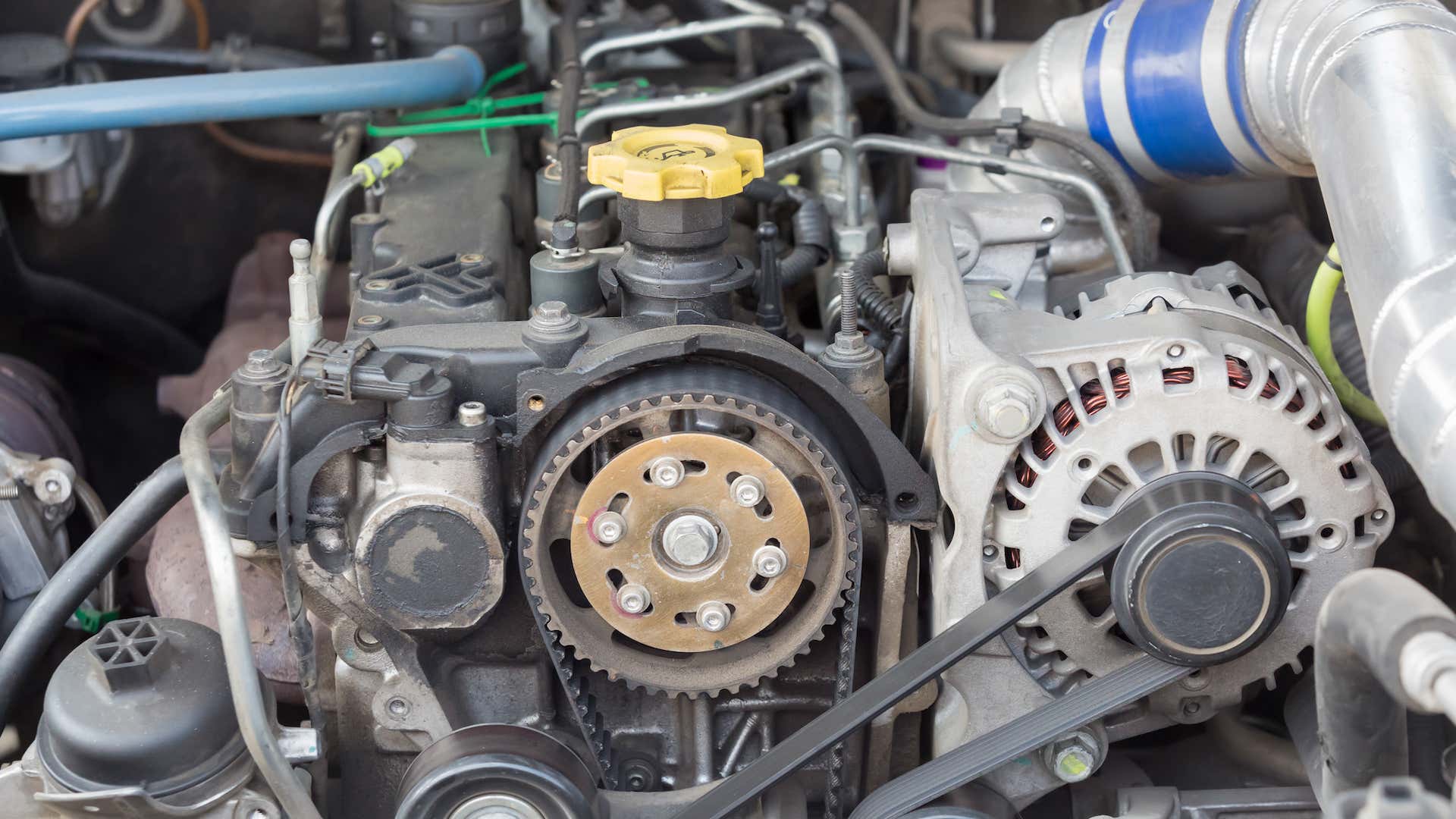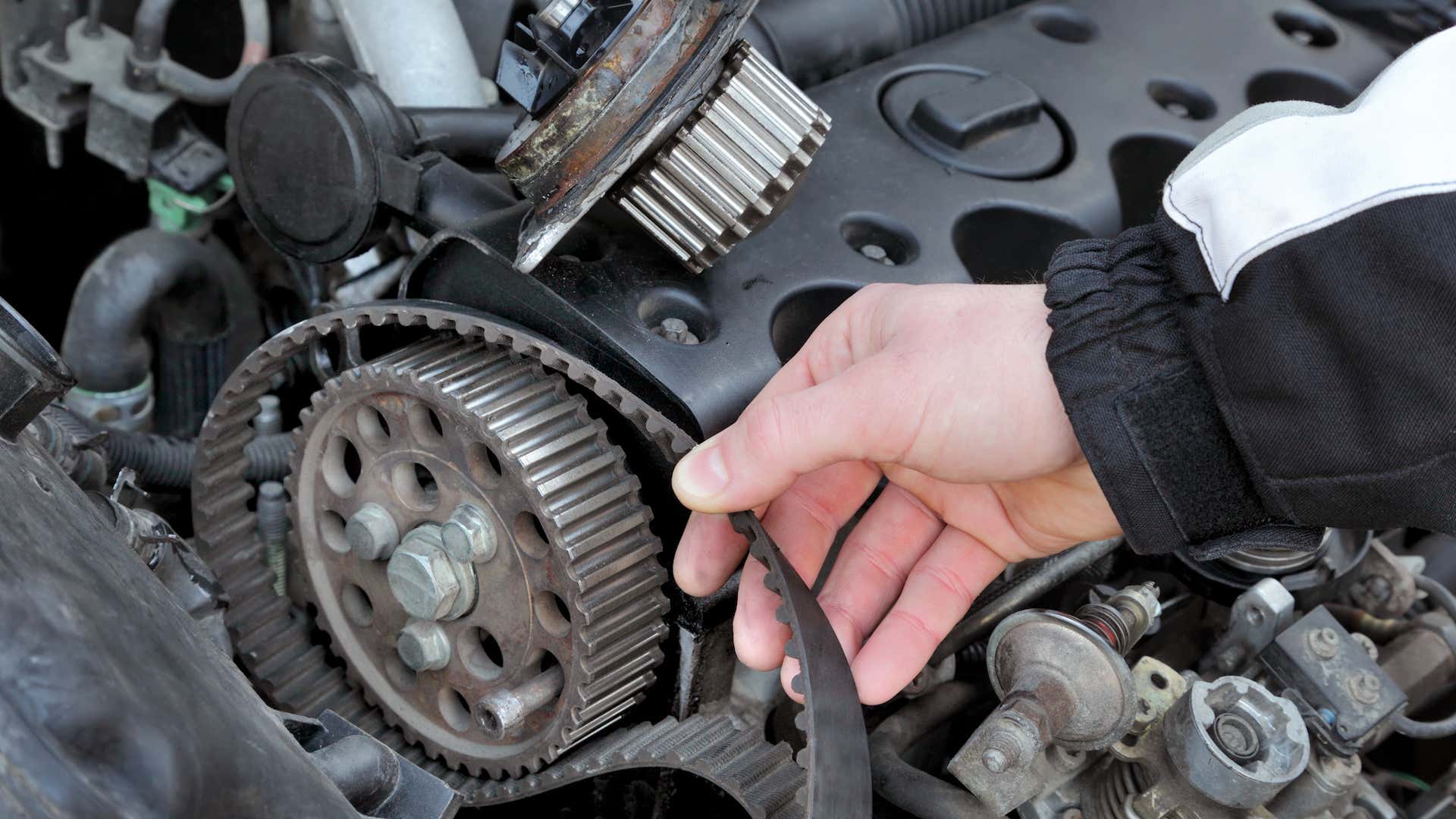The Drive and its partners may earn a commission if you purchase a product through one of our links. Read more.
Unless you own a Yugo, you probably already realize that your car’s engine is a meticulously designed and engineered hunk of metal. Even so, you may not know that if one part of the engine fails, it can take several others to the grave with it. Such is the case with your engine’s timing belt.
Many newer vehicles have timing chains, which don’t have to be replaced or serviced nearly as often, but there are still plenty of new vehicles with timing belts on the road. When it’s time for a timing belt service, it’s not something you can put off. If your timing belt breaks or fails, the collateral damage can add up to thousands of dollars in repairs.
The big thing here is that replacing your own timing belt is a time consuming and highly skilled repair job that we won’t encourage you to do. It’s best to get your vehicle to a shop as soon as possible. We’re not trying to frighten you. This isn’t Scared Straight. All The Drive is trying to do is help you understand the importance of keeping up with timing belt service, though. Let’s get into the details to find out what can happen and how to fix it.
Timing belts are an important part of all sorts of engines.
What Will Happen If The Timing Belt Breaks?
In short, bad things will happen if your timing belt breaks. The belt keeps the crankshaft and the camshaft in sync with each other. This helps the combustion sequence happen at the exact right time to keep the engine running. If the timing belt breaks or fails, your car’s timing could become misaligned and the valves might not open at the right time. Further issues arise if the air and fuel mixture aren’t ignited at the right time, which causes misfires, loss of performance, and more.
If that wasn’t bad enough, a common issue that arises with timing belt problems is that the valves can become bent. There could also be damage to the cylinder head and camshaft. Not good.
Regular maintenance can prevent big headaches.
Symptoms of a Bad Timing Belt
We’re not going to teach you how to replace a timing belt. That would take longer than anyone wants to spend reading. We can, however, give you our pro tips on when to know it’s time to replace a timing belt. Any of the items below can mean it’s time for a timing belt service.
- Do you hear a funny sound? Ticking, squealing, and other knocking sounds should be checked immediately
- Has your engine started leaking oil all of a sudden?
- Do you notice a vibration or shaking sensation out of the blue?
- Has your car’s engine been lethargic and much less powerful than it was before?
- Do you have trouble starting the vehicle or keeping it cool when it’s running?
Timing Belt Safety
We’re hoping you’re taking your car to a shop for timing belt service, but even if you’re just looking around under the hood, you need to be safe about it.
- Don’t start grabbing random parts under the hood, especially if you’ve just finished driving it. Engines and engine components can get extremely hot.
- Don’t wear loose-fitting clothing or dangling jewelry when working under a hood. Not only can you damage your trinkets, getting caught in a spinning belt or gear can cause some nasty injuries.
- It’s a good idea to wear gloves and eye protection, especially when working on older cars. You never know when something will break and send shrapnel flying.
A broken timing belt can result in serious maintenance bills.
How Much Does It Cost To Replace Timing Belt?
Depending on your vehicle, a timing belt service could turn into a big deal and it’s going to be costly. Having a timing belt replaced before it breaks will cost between $500 and $1,000 on average while waiting for it to break before replacing can cost upward of $2,000 or more. Especially, if there’s other damage that occurred in the process.
Can You Drive With A Bad Timing Belt?
No, you cannot. We could really stop right there, but it’s probably best to elaborate a bit. If you suspect the timing belt is bad and you keep driving, you’re looking at the potential for bent valves, damage to the cylinder head and camshaft, and the potential for other internal engine damage. The costs can add up quickly.
Get Help With Signs of a Bad Timing Belt From Mechanic On JustAnswers
The Drive recognizes that while our How-To guides are detailed and easily followed, a rusty bolt, an engine component not in the correct position, or oil leaking everywhere can derail a project. That’s why we’ve partnered with JustAnswers, which connects you to certified mechanics around the globe, to get you through even the toughest jobs.
So if you have a question or are stuck, click here and talk to a mechanic near you.
Featured Products
Anti-fog Safety Goggles
OBDMonster Automotive Timing Ignition Light
AMMEX Industrial Black Nitrile Gloves
Got a question? Got a pro tip? Send us a note: [email protected]
Source: Read Full Article



